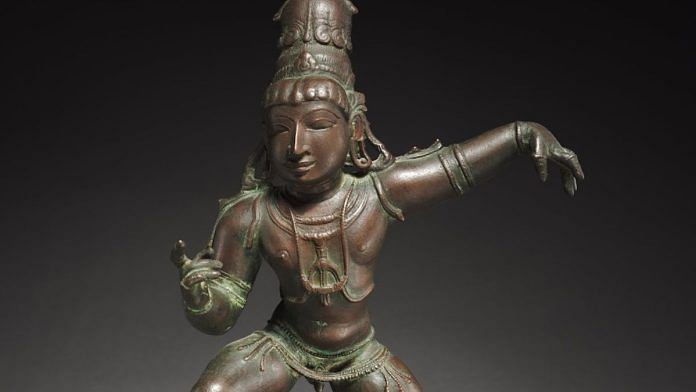Douglas Ober’s Dust on the Throne: The Search for Buddhism in Modern India, published earlier this year by Navayana, has been nominated for the $75,000 Cundill History Prize 2023. The pioneering work overturns accepted narratives about the colonial ‘discovery’ of Buddhism in South Asia and shows how natives were deeply engaged in discourses and practices surrounding the religion. In this excerpt, Ober traces the often violent, medieval and pre-colonial engagement with Buddhism in South Asia. He shows that not only is it wrong to assume that Buddhism had disappeared from India during this period, but how consequential its presence was in religious and courtly contexts.
For the often polyglot populaces of the subcontinent, Sanskrit literature only serves as one domain where intimations of a Buddhist past are stored. Indeed, between the tenth and sixteenth centuries, there was a marked turn towards “vernacular” literature across India (although this process developed much earlier in the south, where linguistic choices in literary traditions were more varied and complex). Literary sources from sixth- to thirteenth-century south India, popularized in later centuries through devotional hymns, temple artworks, and the networks of charismatic saints, provide equally rich—but disturbing—insights into conventional brahmanical views on Buddhists. Many of the most popular devotional works from this period rigorously condemn Buddhists, turning what the religious scholar Anne Monius called a “geography of inclusion” into “a rabidly sectarian vision of the Tamil landscape.” Buddhists (and Jains) are ridiculed for everything from their style of dress and manner of eating to their lack of respect for Vedic rites and the use of the Prakrit rather than refined “classical” tongues.
Nowhere is this enmity more evident than in the poems and narratives surrounding the seventh-century child prodigy, Sambandar (or Campantar). Popularly remembered for his heartfelt prayers to Shiva, and worshipped with offerings across Tamil-speaking south India to this day, Sambandar’s life—like other Shaiva Nayanar poet–saints—was characterized by itinerancy and use of lyrical devotional melodies. His bhakti or devotion was also concerned with converting courtly elites away from Jain and Buddhist institutions. In most of his hymns, Sambandar reserved the tenth verse for the denunciation of the two creeds. Buddhists—clearly identified by their shaved heads and ochre robes—are described as “wicked scoundrels,” “worthless, wily rogues,” and “fat, degenerate men”. In other hymns, they are considered stupid, deluded, overfed, overdressed, linguistically challenged, and the teachers of a dharma that leads to misfortune and ruin.
These signs of stigmatism were sometimes accompanied by violence, as the still popular twelfth-century Tamil epic, Periya Puranam (Great Purana), makes clear. In one of the more memorable stories from this text, Sambandar accepts an invitation to debate with the logician Buddha Nandi, the head (thera) of a local Buddhist vihara. Praying to Shiva for victory, Sambandar recites a single mantra, and the monk’s head is severed from his spine. Aghast, the monk’s disciples challenge him again, insisting this time on a debate conducted not through “flawless mantric disputation” but with “words”. Unfortunately for the Buddhists, they are forced to submit to Shiva’s strength after Sambandar proves that “the omniscience of the Buddha was hollow like his moksa [salvation]”. Whether such violence should be read literally or figuratively is often contested, but the underlying message is the same: Buddhists encourage forms of socially unacceptable behavior. As Wendy Doniger rightly observes, brahmanical criticism of Buddhists was often stated in terms of both orthopraxy and orthodoxy: Buddhists teach people the wrong belief—to stop venerating the Vedas and brahmin castes. With the wrong belief, people will begin doing the wrong things. The justification of these tales may be morally ambiguous by contemporary liberal standards, but in the historical context, these kinds of pedagogies were fundamental in reminding people to “live right”.
Also read: Buddhism has just been reduced to anti-Brahmin thought. But it shaped Hindu reforms too
Although these sources—temple chronicles, devotional poetry, and songs—were widely read and recited in public spaces and religious sites (giving them a popularity not always evident in their small readership), art and iconography were other media through which narratives concerning Buddhists were transmitted across generations. Brahmin literati, land owning castes, and Vishnu-oriented devotees living in early colonial south India, for example, would have been well aware of the Buddhist exploits of Thirumangai Alvar (eighth-to-ninth century), one of the twelve great Tamil poet–saints who espoused bhakti to Vishnu. In a popular story that recalls the early history of the massive Sri Ranganathaswamy Vishnu temple complex at Srirangam—one of the largest Hindu complexes in the world today—Thirumangai, in effect, sanctions theft against Buddhists when hefunds his construction of the temple walls by stealing and melting a golden image of the Buddha housed in the seaside enclave of Nagapattinam. Likewise, at the Lakshmi temple of the Jagannath complex in Puri, a fresco depicts a Vaishnava priest threatening a Buddhist monk at the point of a dagger. Regional accounts recall these incidents in vivid detail. In the twelfth century Odia-language chronicle Madalapanji, the Ganga king, Rajaraja II (c. 1171–94), calls for a debate between brahmins and Buddhists to see “who were omniscient and whose words were true”. Philosophical proofs are laid out, and despite the Buddhists winning, the king executes them. Another story from both a later edition of the Madalapanji and the Bengali-language Chaitanya Bhagavat (c. 1540s) describes the King Madana Mahadeva’s persecution of large groups of Buddhists and the burning of nearly all their manuscripts.
Sixteenth- and seventeenth-century hagiographies circulated in Bengal among Gaudiya Vaishnavas, one of the most successful Vaishnava movements of the past five centuries, provide similarly lively (and antagonistic) depictions of Buddhists. Centered on the Bengali brahmin priest, Chaitanya (c. 1468–1533)—believed by his devotees to be the Mahaprabhu (Great God)—this movement may have only gained popularity in the nineteenth century, but its sixteenth and seventeenth century luminaries produced a number of influential manuscripts detailing Chaitanya’s interactions with Buddhists. In the Chaitanya Charitamrita (c. 1540s), the author Krishnadasa Kaviraja describes Chaitanya’s visit to a village led by a young Buddhist acharya (master) near Vriddha-Kasi in present-day Tamil Nadu. Despite admitting that Buddhists are unfit to be conversed with or even seen, Chaitanya agrees to debate with the acharya in order to shatter his pride. Expectedly, the acharya is humiliated by Chaitanya’s wit and logic. However, rather than surrendering and “converting” to the opponent’s position, as is often the custom in these stories, the acharya and his disciples try to poison Chaitanya by offering him a plate of impure food (apavitra anna) disguised as a religious offering (prasad). At the very moment the food is being offered, a large bird swoops down, grasps the plate, sweeps back into the sky and drops the plate on the acharya’s head, striking him dead. Terrified, the acharya’s disciples beg Chaitanya to revive their guru. In his great compassion, Chaitanya does so but only after ordering all of the Buddhists to join in singing praise to Krishna (Krishna sankirtan). At that moment, the defeated acharya wakes with the word of God (Krishnabali) bursting from his mouth.
In the many religious debates that took place at the Mughal emperor Akbar’s (r. 1556–1605), imperial court, Jain theologians and brahmin intellectuals argued about the connection of Buddhist doctrines to Shaiva and Islamic conceptions of a monotheistic God (paramishvara). In fact, Akbar’s vizir and court historian, Abu al’Fazl (1551–1602), wrote at length about the “tribe of Boodh [Buddha]”. Buddhists appear in all three volumes of his Persian-language Ain-e-Akbari, including a comprehensive report in Volume III where he describes four different schools of Buddhist philosophy, the nature of Buddhist praxis, brahmanical antagonism towards Buddhists, and the widespread influence that Buddhists once held over the land. Long after Akbar’s reign, Mughal rulers continued to engage in political negotiation with Buddhist monastic governments at both ends of the Himalayas, showing significant familiarity with their customs and doctrines. Even in seventeenth-century Rajasthan, where Buddhism had been supplanted nearly a millennium before, Buddhists continued to be spoken about in the songs and hymns of the Dadupanthis. This devotional sect of monastic and lay communities, founded by the sant, Dadu (1554–1603), taught that Buddhists were one of the six schools (saddarshana) who “wear false religious costumes” (sabai kapata ke bhekha). Some six hundred miles south of the Dadupanthis’ karmabhoomi, a host of Maharashtrian saints and their devotees extolled the name of the Buddha in art, sculpture, and poetry. Except now, his Vishnu-inspired identity as the incarnation (avatar) of deception had been transfigured into the holy persona of Vitthal (Vithoba), the most popular god in the western state. The phenomenon led Ramachandra Chintaman Dhere, the great scholar of Maharashtrian culture, to declare: “In Indian traditions nothing ever gets destroyed: it only gets transformed, taking on different names and forms”.
The violence and othering contained in so many of these texts are striking. While some scholars argue that these features are clear manifestations of social tensions, others argue that the hostilities evidenced in literary sources are not visible in archaeological records. They point to what appears as a long history of religious pluralism at sites like Bodh Gaya, Amaravati, Nagarjunakonda, Ellora, and elsewhere. In everyday practice, religious identity in South Asia has largely been malleable and dependent on context, yet it is also clear that caste and ethnic-group practices are tied to familial and communal traditions that police peoples’ behaviors and thoughts. Religious communalism is not inevitable, and a broad examination of Indic history reveals as much intra-religious sectarianism as it does extra-religious animosity. Buddhists argued amongst one another as vociferously as they did with non-Buddhists. They were also vicious in their denunciations of brahmins and no less invested in polemics.
 This is an edited excerpt where the academic notes and references have been removed. Excerpted with permission from Navayana.
This is an edited excerpt where the academic notes and references have been removed. Excerpted with permission from Navayana.



